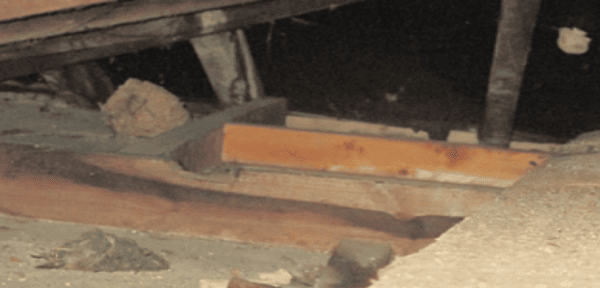Asbestos – Case Studies.

Case Study 1
A surveyor recently undertook an inspection of a 1920s property. The construction of the bedroom ceilings ran an initial alarm bell, especially the cover battens to the boards joints.
Following the trail, inspection of roof space provided further cause for suspicion. The material used for the ceiling board has an ‘orange peel texture’ suggesting a semi compressed board e.g. asbestolux.

Sure enough, on testing, this particular property was found to have ceilings made with an asbestos containing board, eventually removed at considerable cost to the home owner. Please note, if you suspect the ceiling may be made of asbestos containing material, take extra care not to disturb anything in the loft and do not touch or move any thermal insulation’.

In this case study the ‘loft side’ of the ceiling board was clearly visible. But of course, In some situations, it is simply not possible to see the other side of ceiling boards mainly due to the inspection limitations. (boarding, insulation laid on ceiling joists, no access to roof space, personal storage laid over joists) In these cases the worst-case scenario should be assumed, which is that the ceiling contains a potential ACM material and should be reported as such.

Presence of any potential ACM containing material within a property must be noted in the site notes and reflected in the report. Sava has investigated a couple of claims which succeeded because the Surveyor failed to report to the client that the ceiling material was a possible ACM even though no repair was needed. This type of complaint is almost impossible to defend. The probability of a complaint related to ACM material turning into claim is very high, two in three cases will result in payment.
Thorough inspection, clear marking in site notes, comprehensive reflection and inclusion in the report will avoid the unnecessary stress and frustration on both sides. You will not know for certain if an Artex ceiling dating from the 1980s will contain asbestos. (It is impossible to be certain without taking a sample for laboratory testing) but you must report it as a possible ACM and as a potential risk to people. (Section C in the Home Condition Survey).
Case Study 2
This relates to a bungalow built around 1925 that needed some renovation works after purchase.
The construction of the ceiling in the kitchen should have rung alarm bells for the surveyor, particularly in relation to the age of the property.
There was access to the loft on the date of inspection and while some of the ceilings were insulated, the ceiling immediately above the kitchen was not. However, access was difficult and the surveyor could not get close enough to see if the ceiling was a likely AIB material.

The surveyor reported, in this case wrongly, that the ceilings were all plasterboard. As a result, there was a successful claim by the purchaser. Although the surveyor could not get close enough to see the texture of the ceiling board to confirm possible AIB, it would have been more prudent to report that some construction materials could have contained asbestos, particularly as suspicions were aroused by the unusual ceiling construction.
Read more about the History of Asbestos and Asbestos containing materials